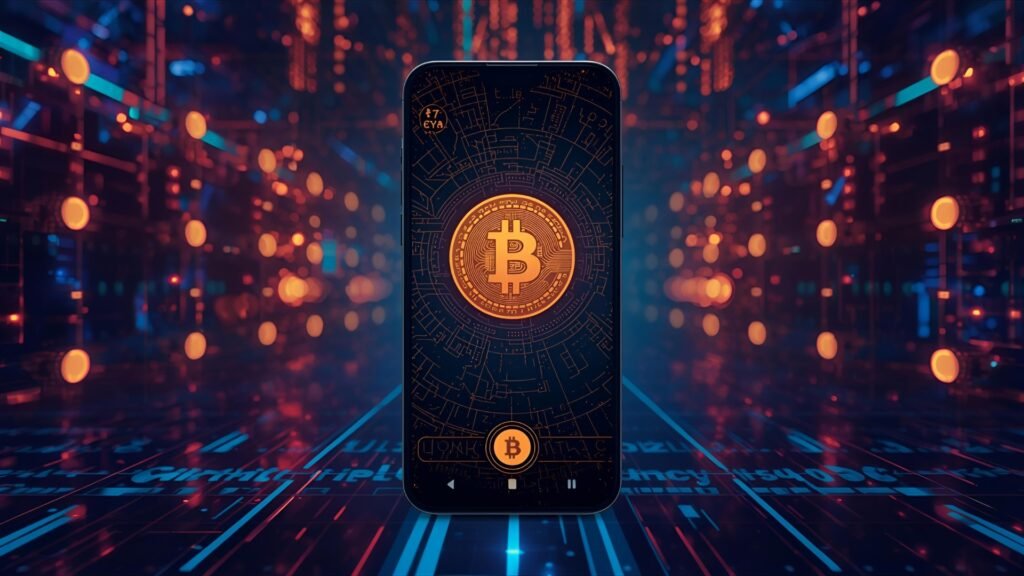The idea of earning Bitcoin while you sleep has never been more compelling. With improvements in mobile hardware, lighter client software, and cloud-integrated services, the best Bitcoin mining app 2025 promises a smoother on-ramp to crypto for beginners and a convenient side stream for veterans. While mobile phones will not rival dedicated ASICs.
The right app can blend user-friendly wallets, automated payouts, and low-latency pool access into a single experience that feels like true passive income. In this guide, you’ll learn how mining from your phone really works, how to evaluate apps, what revenue to expect, and how to avoid scams. By the end, you’ll have a realistic, step-by-step path to start mining Bitcoin from your pocket—safely, efficiently, and with clarity about the risks and rewards.
Mobile Bitcoin Mining in 2025
Mobile mining has evolved from a novelty to a supporting role in the broader ecosystem. Instead of raw hashing power, most modern apps emphasize orchestration, mining pool participation, and sometimes cloud mining back-ends that offload the heavy lifting to data centers. Your phone becomes a dashboard, identity layer, and wallet rather than the main engine.
Why phones don’t hash like ASICs
Bitcoin’s Proof of Work relies on computationally intense SHA-256 hashing. Specialized ASIC miners produce terahashes per second, while even the newest smartphones are orders of magnitude weaker and thermally constrained. Genuine on-device hashing will drain your battery, generate heat, and yield negligible rewards. Consequently, the best Bitcoin mining app 2025 will typically connect you to a pool or hashrate marketplace, or it will manage cloud hashrate you rent, consolidating earnings in your mobile wallet with minimal local computation.
The “passive income” promise—made realistic
“Passive income” is appealing, but it must be anchored in reality. If the app is purely local hashing, your earnings will be tiny. If it’s a hybrid that taps into cloud hashrate or a cooperative pool, your earnings can be steadier but still variable based on network difficulty, BTC price, pool fees, and uptime. Real passive income comes from systems that run reliably with minimal user intervention, not from get-rich-quick schemes. In 2025, the winning approach usually combines phone-based orchestration with professionally run infrastructure.
Makes the Best Bitcoin Mining App in 2025

Not all apps are equal. The best Bitcoin mining app 2025 checks a dozen boxes you can verify before funding anything. Beyond glossy interfaces, prioritize transparency and control.
Transparent earnings math
An app should explain expected yield clearly using network hash rate, block rewards, and pool fee parameters. It should offer a projection tool you can adjust for BTC price assumptions, maintenance fees, and uptime. If the app hides these inputs or only shows aspirational daily profit numbers, treat that as a red flag.
Secure, self-custody options
Security is everything. Ideally, the app integrates a non-custodial wallet with seed phrases you control, letting you withdraw Bitcoin rewards to any address. If it’s custodial, it should support 2FA, withdrawal whitelists, and transaction alerts. The more control you have, the safer your earnings.
Real pool or cloud integration
Look for named, reputable mining pools or cloud providers that publish uptime stats and fee schedules. If the provider is anonymous, if payouts are opaque, or if the app promises fixed daily returns regardless of network difficulty, that’s inconsistent with how Bitcoin mining truly works.
Battery and thermal management
If the app offers local hashing as a learning feature, it must include thermal throttling and battery protections. A smart app pauses on low battery, prevents runaway heat, and favors scheduled sessions when your phone is plugged in and connected to Wi-Fi.
Fair fees and simple withdrawals
Read the fee structure carefully: pool fee, maintenance fee for cloud hashrate, in-app service fee, and withdrawal minimums. The best apps keep fees competitive and withdrawals straightforward, with transaction histories you can export for taxes and audits.
Privacy and KYC clarity
Many cloud or custodial setups require KYC. That’s standard for regulated providers, but the app should say what data it collects, how it stores it, and when it shares it. If you prefer privacy, look for services that minimize data collection and still comply with local rules.
How a Modern Mining App Works from Your Phone
Most high-quality apps follow a predictable flow, helping you avoid friction and missteps.
Account and wallet setup
You’ll download the app, create an account, and secure your wallet. If it’s self-custodial, you’ll back up a seed phrase. If it’s custodial, you’ll set strong 2FA. The wallet is where Bitcoin rewards accumulate and from which you can withdraw to an external address.
Connecting to a pool or allocating cloud hashrate
Next, you’ll select a mining pool or choose a cloud mining plan. For pool connections, the app assigns you a worker ID and shares. For cloud plans, you allocate hashrate by TH/s or PH/s and choose payout frequency. The app displays real-time earnings, historical payouts, and efficiency metrics.
Earnings tracking and auto-withdrawal
You’ll see pending and confirmed rewards, net of pool fees and any maintenance costs. The best apps allow auto-withdrawal once a threshold is met, sending BTC to your external wallet on a schedule. This automation is what turns sporadic income into a more “passive” flow.
Evaluating Profitability Without Guesswork

Profit depends on inputs you can quantify. Understanding them will keep your expectations realistic.
Network difficulty and BTC price
Higher difficulty means more competition, reducing your share for a given hashrate. Rising BTC price can offset this by increasing the fiat value of rewards. Profit models should let you stress-test both variables at different levels.
Fees and maintenance
Every percentage point matters. A 2% pool fee plus a 20% maintenance fee for cloud plans can significantly reduce net yield. Choose transparent providers and compare fee schedules before committing capital.
Uptime and latency
Mining is a game of continuous participation. Frequent disconnects, high latency, or outages will lower your share of rewards. Apps that show uptime logs and offer multiple pool endpoints are easier to trust.
Energy and opportunity costs
If you experiment with local hashing, factor energy consumption and battery wear. For cloud hashrate, consider the opportunity cost: could the same capital perform better in BTC DCA, staking derivative strategies, or liquidity programs? There is no single right answer—only trade-offs aligned with your risk tolerance.
Features to Look for in the Best Bitcoin Mining App 2025
The strongest contenders have converged around a similar feature set that balances ease of use and power.
Clean UX with expert mode
Beginners need a guided setup and plain-language explanations. Advanced users want manual pool selection, PPS/PPLNS payout options, and exportable logs. A good app offers both, with toggles for advanced settings when you’re ready.
Wallet flexibility and security
Support for SegWit addresses, Taproot, and hardware wallet integration strengthens your security posture. Extra points for multisig support and watch-only modes that let you monitor payouts without exposing keys.
Revenue analytics and alerts
Charts that break down daily hashrate, payout variance, and fee impact help you optimize. Alerts for payout received, hash rate deviations, or pool failover keep you informed without babysitting the app.
Compliance and localization
Support for local fiat on-ramps, tax reports, and regional KYC norms reduces friction. Clear country support lists minimize the risk of service interruptions where crypto rules are in flux.
Read More: Free Bitcoin Mining Passive Income Without Investment 2025
Cloud Mining vs. Mobile Hashing: Which Is Better?
The phrase “mining from your phone” can mean two different things. Understanding the difference will save you time and money.
Local hashing on-device
On-device hashing demonstrates the mechanics of mining, but yields are negligible relative to energy and heat. It can be educational, but it won’t generate meaningful passive income in 2025.
Cloud hashrate with mobile orchestration
Renting remote hashrate is where most mobile users see results. Your phone controls allocation, tracks rewards, and manages withdrawals while data centers do the hashing. This model scales, but it introduces counterparty risk. Always vet the provider, read contracts, and test with small allocations before scaling up.
Risk Management: Protecting Your Bitcoin and Your Time
Mining is not risk-free. The best app helps you manage threats you can’t avoid entirely but can mitigate.
Counterparty and platform risk
Cloud providers can fail or disappear. Reduce exposure by splitting allocations across multiple platforms, enabling auto-withdrawal, and moving funds to a self-custody wallet regularly.
Market volatility
BTC price moves fast. Use conservative assumptions and avoid leveraging future payouts. Mining returns can lag price cycles; patience and risk budgeting matter.
Security hygiene
Enable 2FA, use strong unique passwords via a reputable manager, and never share your seed phrase. Treat mining dashboards like online banking. If the app offers address whitelists, use them.
Regulatory shifts
Crypto regulations evolve. An app that communicates policy changes and provides KYC/AML guidelines protects you from surprise service disruptions. Monitor announcements and maintain alternative withdrawal routes.
Step-by-Step: Getting Started with a Mining App Today
Starting small is the smartest move. The right sequence will keep you safe while you learn.
Choose a reputable app and verify providers
Install a well-reviewed app with public documentation and provable mining pool or cloud mining partnerships. Verify pool names, endpoints, fee schedules, and service-level commitments. The more open the app is about its partners, the better.
Secure your wallet before funding
Decide between custodial and non-custodial. If you hold the keys, back up the seed phrase offline. If the app holds them, enable every security control and set up withdrawal whitelists.
Fund conservatively and run a trial
Allocate a small amount of BTC or fiat to rent cloud hashrate. Track rewards and confirm that payouts post as promised. Export logs and test a withdrawal to your external wallet.
Optimize with data
After a week or two, examine your payout variance, effective hashrate, and fees. If the app supports multiple pools or regions, compare uptime and latency. Tweak allocations gradually, always keeping a safety margin.
Red Flags: How to Avoid Mining App Scams
Scammers prey on the dream of effortless passive income. Protect yourself by recognizing common warning signs.
Guaranteed daily returns
Bitcoin mining can be modeled, not guaranteed. If an app promises fixed returns unrelated to network difficulty or BTC price, it isn’t mining—it’s marketing at best, or worse.
Opaque ownership and zero audits
Legitimate providers list leadership, corporate registration, and third-party security audits. Anonymous teams, no addresses, and no audits should push you to walk away.
Withdrawal hurdles and hidden fees
Complex withdrawal rules, high minimums, or surprise fees indicate liquidity problems. Test withdrawals early and often. Transparent apps want you to move funds freely.
The Role of L2s and Side Protocols in 2025
While Bitcoin’s base layer is immutable and conservative, the surrounding ecosystem has grown. Some mining apps now layer services on top of Bitcoin to improve user experience.
Lightning payouts and microstreams
Lightning Network enables micro-payouts, settling rewards more frequently with minimal fees. Apps that support Lightning can reduce friction for small miners, letting you compound faster or route earnings into spending balances.
Merge mining and auxiliary rewards
Some infrastructures support merge mining or auxiliary tokens on side protocols. While interesting, treat these as bonuses rather than core ROI drivers. Conservative miners focus on BTC-denominated returns.
Overlooked Factors That Impact Results
Small details compound over time. The best miners obsess over predictable execution.
Time in market beats timing the market
Mining rewards are stochastic. Longer participation smooths variance. If you plan to mine via cloud services, choose plans that match your horizon and set realistic expectations.
Automation turns effort into yield
Auto-withdrawals, alerting, and failover reduce downtime and emotional decision-making. The more you automate within safe bounds, the more “passive” your mining becomes.
Taxes matter
Track cost basis, payout timestamps, and fees. Exportable CSVs and integrated tax reports save hours later. Set calendar reminders for quarterly obligations where applicable.
How to Scale Your Phone-Based Mining Setup
Once your trial proves out, you can expand prudently.
Diversify providers and payout paths
Split hashrate across two or three reputable platforms. Use both on-chain and Lightning payouts. Store larger balances in cold storage and keep only operational amounts on custodial services.
Reinvest or DCA?
Reinvesting your payouts into additional hashrate can boost BTC-denominated yield during favorable difficulty cycles. Alternatively, DCA into spot BTC with a portion of your payouts to balance risk. Choose a policy and stick to it.
Monitor fundamentals
Watch difficulty adjustments, hashprice trends, and energy market news. While you don’t need to become an industry analyst, understanding the big signals helps you decide when to scale or pause allocations.
Ethical and Environmental Considerations
Mining’s footprint matters. Even if you’re using cloud hashrate, you’re implicitly choosing energy sources.
Prefer greener providers
Some data centers procure renewable energy, publish energy mix reports, or participate in demand-response programs. Supporting greener operators encourages responsible growth.
Understand externalities
Mining can stabilize grids by consuming excess energy, but it can also strain resources if done irresponsibly. When evaluating providers, weigh energy efficiency claims and look for independent verification.
Conclusion
Mobile mining has matured into a practical gateway to Bitcoin’s infrastructure. Your phone can orchestrate cloud hashrate, route payouts, and secure your BTC without noisy rigs at home. The best Bitcoin mining app 2025 blends transparent earnings math, strong security, fair fees, and automation that turns sporadic payouts into something truly passive. Treat the process like a small business: verify providers, manage risk, track results, and grow at a pace you control. Do that, and you’ll transform a curious experiment into a sustainable, long-term strategy for earning Bitcoin from your pocket.
FAQs
Q: Can I really earn meaningful passive income from a phone?
Yes, but not from raw on-device hashing. Meaningful income usually comes from apps that connect you to cloud mining or reputable mining pools. Your phone manages settings, security, and withdrawals while data centers perform the hashing. Earnings depend on difficulty, fees, and BTC price.
Q: How much should I start with?
Begin with a small allocation you can afford to experiment with, then evaluate a week or two of payout data, uptime, and fee impact. Once you’ve tested withdrawals and confirmed transparency, consider scaling in measured steps.
Q: Are mining apps safe?
They can be, if you choose well. Favor apps with non-custodial wallets, 2FA, and named pool or cloud partners. Avoid platforms promising fixed daily returns or hiding ownership, fees, or audits. Always enable withdrawal whitelists where available.
Q: What about taxes on mining rewards?
Mining payouts are typically taxable. Keep exportable CSV reports, note payout timestamps, and track your cost basis. Consult local rules and, if needed, a crypto-savvy accountant to stay compliant.
Q: Is cloud mining better than buying BTC directly?
It depends on your goals and market conditions. Cloud mining can accumulate BTC through operational yield but introduces counterparty and fee risks. Buying spot BTC is simpler and avoids platform risk. Many users blend both, allocating part to mining and part to DCA for diversification

















